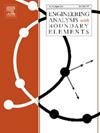Efficient exact quadrature of regular solid harmonics times polynomials over simplices in R3
IF 4.2
2区 工程技术
Q1 ENGINEERING, MULTIDISCIPLINARY
Engineering Analysis with Boundary Elements
Pub Date : 2024-11-15
DOI:10.1016/j.enganabound.2024.106023
引用次数: 0
Abstract
A generalization of a recently introduced recursive numerical method (Gumerov et al., 2023) for the exact evaluation of integrals of regular solid harmonics and their normal derivatives over simplex elements in is presented. The original Quadrature to Expansion (Q2X) method (Gumerov et al., 2023) achieves optimal per-element asymptotic complexity for computing integrals of all regular solid harmonics bases with truncation degree by exploiting recurrence relations of the regular solid harmonics as well as the flatness and straightness of the faces and edges, respectively, of simplex elements. However, it considered only constant density functions over the elements. Here, we generalize this method to support arbitrary degree polynomial density functions, which is achieved in an extended recursive framework while maintaining the optimality of the per-element complexity for evaluating all regular solid harmonics and monomial density functions. The method is derived for 1- and 2- simplex elements in and can be used for the boundary element method and vortex methods coupled with the fast multipole method.
R3 中简约上正则实体谐波乘多项式的高效精确正交
本文介绍了对最近引入的递归数值方法(Gumerov 等人,2023 年)的推广,该方法用于精确计算 R3 中单元上的正则实体谐波积分及其正导数。最初的正交展开(Q2X)方法(Gumerov 等人,2023 年)通过利用正交实体谐波的递推关系以及简元的面和边分别具有的平面度和直线度,在计算截断度为 ps 的所有正交实体谐波基的 O(ps2)积分时实现了最优的每元素渐近复杂度。但是,它只考虑了元素上的恒密度函数。在这里,我们将这种方法推广到支持任意度多项式密度函数,这是在一个扩展递归框架中实现的,同时保持了评估所有正则实体谐波和单项式密度函数的每元素复杂性的最优性。该方法适用于 R3 中的 1- 和 2- 单纯形元素,可用于边界元素法和与快速多极法相结合的涡流法。
本文章由计算机程序翻译,如有差异,请以英文原文为准。
求助全文
约1分钟内获得全文
求助全文
来源期刊

Engineering Analysis with Boundary Elements
工程技术-工程:综合
CiteScore
5.50
自引率
18.20%
发文量
368
审稿时长
56 days
期刊介绍:
This journal is specifically dedicated to the dissemination of the latest developments of new engineering analysis techniques using boundary elements and other mesh reduction methods.
Boundary element (BEM) and mesh reduction methods (MRM) are very active areas of research with the techniques being applied to solve increasingly complex problems. The journal stresses the importance of these applications as well as their computational aspects, reliability and robustness.
The main criteria for publication will be the originality of the work being reported, its potential usefulness and applications of the methods to new fields.
In addition to regular issues, the journal publishes a series of special issues dealing with specific areas of current research.
The journal has, for many years, provided a channel of communication between academics and industrial researchers working in mesh reduction methods
Fields Covered:
• Boundary Element Methods (BEM)
• Mesh Reduction Methods (MRM)
• Meshless Methods
• Integral Equations
• Applications of BEM/MRM in Engineering
• Numerical Methods related to BEM/MRM
• Computational Techniques
• Combination of Different Methods
• Advanced Formulations.
 求助内容:
求助内容: 应助结果提醒方式:
应助结果提醒方式:


